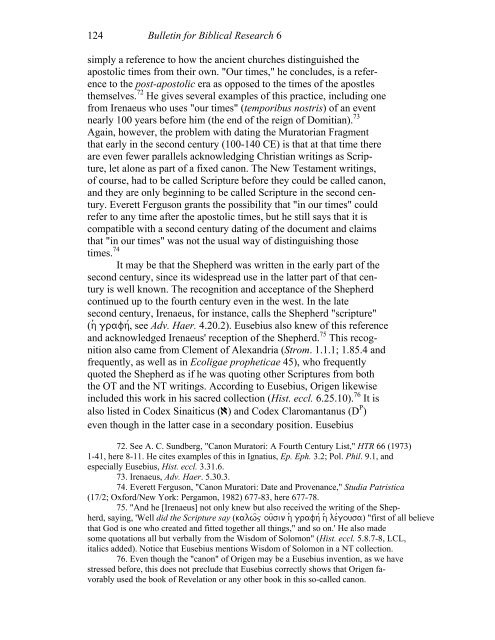The Integrity of the Biblical Canon in Light of Its Historical ...
The Integrity of the Biblical Canon in Light of Its Historical ...
The Integrity of the Biblical Canon in Light of Its Historical ...
Create successful ePaper yourself
Turn your PDF publications into a flip-book with our unique Google optimized e-Paper software.
124 Bullet<strong>in</strong> for <strong>Biblical</strong> Research 6<br />
simply a reference to how <strong>the</strong> ancient churches dist<strong>in</strong>guished <strong>the</strong><br />
apostolic times from <strong>the</strong>ir own. "Our times," he concludes, is a reference<br />
to <strong>the</strong> post-apostolic era as opposed to <strong>the</strong> times <strong>of</strong> <strong>the</strong> apostles<br />
<strong>the</strong>mselves. 72 He gives several examples <strong>of</strong> this practice, <strong>in</strong>clud<strong>in</strong>g one<br />
from Irenaeus who uses "our times" (temporibus nostris) <strong>of</strong> an event<br />
nearly 100 years before him (<strong>the</strong> end <strong>of</strong> <strong>the</strong> reign <strong>of</strong> Domitian). 73<br />
Aga<strong>in</strong>, however, <strong>the</strong> problem with dat<strong>in</strong>g <strong>the</strong> Muratorian Fragment<br />
that early <strong>in</strong> <strong>the</strong> second century (100-140 CE) is that at that time <strong>the</strong>re<br />
are even fewer parallels acknowledg<strong>in</strong>g Christian writ<strong>in</strong>gs as Scripture,<br />
let alone as part <strong>of</strong> a fixed canon. <strong>The</strong> New Testament writ<strong>in</strong>gs,<br />
<strong>of</strong> course, had to be called Scripture before <strong>the</strong>y could be called canon,<br />
and <strong>the</strong>y are only beg<strong>in</strong>n<strong>in</strong>g to be called Scripture <strong>in</strong> <strong>the</strong> second century.<br />
Everett Ferguson grants <strong>the</strong> possibility that "<strong>in</strong> our times" could<br />
refer to any time after <strong>the</strong> apostolic times, but he still says that it is<br />
compatible with a second century dat<strong>in</strong>g <strong>of</strong> <strong>the</strong> document and claims<br />
that "<strong>in</strong> our times" was not <strong>the</strong> usual way <strong>of</strong> dist<strong>in</strong>guish<strong>in</strong>g those<br />
times. 74 It may be that <strong>the</strong> Shepherd was written <strong>in</strong> <strong>the</strong> early part <strong>of</strong> <strong>the</strong><br />
second century, s<strong>in</strong>ce its widespread use <strong>in</strong> <strong>the</strong> latter part <strong>of</strong> that century<br />
is well known. <strong>The</strong> recognition and acceptance <strong>of</strong> <strong>the</strong> Shepherd<br />
cont<strong>in</strong>ued up to <strong>the</strong> fourth century even <strong>in</strong> <strong>the</strong> west. In <strong>the</strong> late<br />
second century, Irenaeus, for <strong>in</strong>stance, calls <strong>the</strong> Shepherd "scripture"<br />
(h( grafh/, see Adv. Haer. 4.20.2). Eusebius also knew <strong>of</strong> this reference<br />
and acknowledged Irenaeus' reception <strong>of</strong> <strong>the</strong> Shepherd. 75 This recognition<br />
also came from Clement <strong>of</strong> Alexandria (Strom. 1.1.1; 1.85.4 and<br />
frequently, as well as <strong>in</strong> Ecoligae propheticae 45), who frequently<br />
quoted <strong>the</strong> Shepherd as if he was quot<strong>in</strong>g o<strong>the</strong>r Scriptures from both<br />
<strong>the</strong> OT and <strong>the</strong> NT writ<strong>in</strong>gs. Accord<strong>in</strong>g to Eusebius, Origen likewise<br />
<strong>in</strong>cluded this work <strong>in</strong> his sacred collection (Hist. eccl. 6.25.10). 76 It is<br />
also listed <strong>in</strong> Codex S<strong>in</strong>aiticus ()) and Codex Claromantanus (D P )<br />
even though <strong>in</strong> <strong>the</strong> latter case <strong>in</strong> a secondary position. Eusebius<br />
72. See A. C. Sundberg, "<strong>Canon</strong> Muratori: A Fourth Century List," HTR 66 (1973)<br />
1-41, here 8-11. He cites examples <strong>of</strong> this <strong>in</strong> Ignatius, Ep. Eph. 3.2; Pol. Phil. 9.1, and<br />
especially Eusebius, Hist. eccl. 3.31.6.<br />
73. Irenaeus, Adv. Haer. 5.30.3.<br />
74. Everett Ferguson, "<strong>Canon</strong> Muratori: Date and Provenance," Studia Patristica<br />
(17/2; Oxford/New York: Pergamon, 1982) 677-83, here 677-78.<br />
75. "And he [Irenaeus] not only knew but also received <strong>the</strong> writ<strong>in</strong>g <strong>of</strong> <strong>the</strong> Shepherd,<br />
say<strong>in</strong>g, 'Well did <strong>the</strong> Scripture say (kalw=j ou=s<strong>in</strong> h( grafh/ h( le/gousa) "first <strong>of</strong> all believe<br />
that God is one who created and fitted toge<strong>the</strong>r all th<strong>in</strong>gs," and so on.' He also made<br />
some quotations all but verbally from <strong>the</strong> Wisdom <strong>of</strong> Solomon" (Hist. eccl. 5.8.7-8, LCL,<br />
italics added). Notice that Eusebius mentions Wisdom <strong>of</strong> Solomon <strong>in</strong> a NT collection.<br />
76. Even though <strong>the</strong> "canon" <strong>of</strong> Origen may be a Eusebius <strong>in</strong>vention, as we have<br />
stressed before, this does not preclude that Eusebius correctly shows that Origen favorably<br />
used <strong>the</strong> book <strong>of</strong> Revelation or any o<strong>the</strong>r book <strong>in</strong> this so-called canon.
















